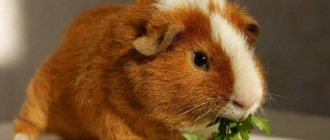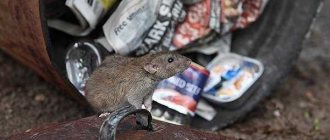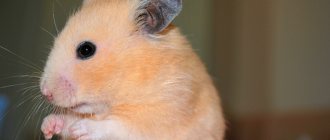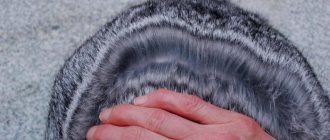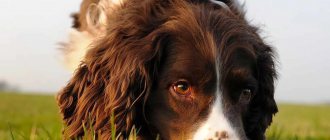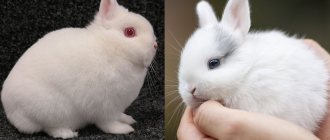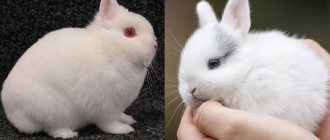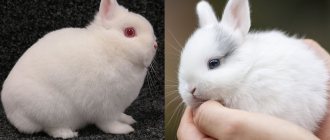Guinea pig - characteristics and description
The domesticated pig became a sea pig because it was brought from another continent, that is, it was originally overseas. The pet, which arrived from America, became loved not only in Europe, but also in Russia. The animal was called a pig because sometimes it makes a sound similar to grunting.
The pet's character is kind and trusting. The pig is completely tame and loves to play with its owner.
It is necessary to ensure that the guinea pig does not fall even from a small height - this can be fatal.
In addition to grunting, the animal makes various sounds: purring, rumbling. This mainly happens during the mating season, when males are courting their mate. Females can sometimes tweet for 2-10 minutes at night, this happens during pregnancy or in the absence of a partner for a long time.
The average pet has a body length from 23 to 36 cm, depending on the species. The weight of a male is 1020 - 1550 g, females from 750 to 1250 g.
Life expectancy is on average 10 - 12 years; in good conditions, an animal can live 15 years, but this is a record figure.
Interesting facts about the rodent:
- Guinea pigs were domesticated in the 5th millennium BC. e. Andean tribes of South America (today Colombia, Ecuador, Peru and Bolivia) in order to eat rodent meat. During archaeological excavations in Peru and Ecuador, statues of guinea pigs were found dating back to 500 BC. e. before 500 AD e. They were worshiped by the Mochica people. Nowadays, in South America, guinea pigs continue to be eaten (in Peru, up to 65 million animals are used for this purpose per year). Guinea pig meat is similar in taste and nutritional value to rabbit and chicken meat, and is considered dietary.
- Selection work to develop guinea pig breeds lasted from 1200 to 1532. And during the period of the Great Geographical Discoveries, traders from Spain, Holland and England brought pigs to Europe, where they gained popularity as pets at royal courts (for example, Queen Elizabeth I of England).
- The scientific name of the species "Cavia porcellus" is Latin for "little pig". Breeders often use the more formal name cavy or cavey. The comparison of these animals with pigs is not entirely clear. Possible causes include the characteristic sounds guinea pigs make, the proportions of their head to body size, their thick necks, and lack of a waist. In addition, guinea pigs constantly eat and live in small pens that were used to breed pigs on ships, which makes them generally similar to ordinary pigs.
- Guinea pigs are capable of making a variety of sounds, each of which has its own designation. So, during pregnancy, females, and sometimes males too, make chirping sounds that are vaguely similar to birdsong. Guinea pigs “chirp” for 2 to 15 minutes, usually at dusk or at night. When courting females, males make rumbling sounds, a kind of “mating song.” Similar sounds are also characteristic of dominant pigs, which live together with a group of relatives, and with their help show which of them is in charge.
- Penicillin is a deadly poison for guinea pigs.
Guinea pig color
The porpoise has the following colors:
- Self – plain cream, black, red colors.
- Dalmatian - light base with specks (small specks of a dark shade).
- Dutch is a combination of two colors, where the muzzle and back of the body differ in color from the entire body.
- Himalayan - a light-colored carcass is decorated with dark paws, nose, and ears.
- Agouti is a special bright color in which the hair roots are colored in different shades.
- A combination of several colors: spots of different shades are scattered throughout the fur coat, which contrast with each other.
- Tortoiseshell – two colors creating a variegated pattern.
Types of guinea pigs
The Peruvian guinea pig is divided into the following types:
- With short hair:
- American (simple smooth). This is the most common species on all continents, an ordinary or mongrel pig. She has short hair on her body, growing from her head to her back. Characteristic features of the species are a wide nose with a hump and a large selection of colors. Friendly and unpretentious in nature, this is an excellent breed for beginners.
- The Rex is a short-haired breed with a thick coat that resembles the fur of rabbits of the same name. Rex hair length does not exceed 3.5 cm, and they do not have guard hairs in their coat, so their fur is very dense, curly and unruly. Their fur is so pleasant to stroke that you will not be able to let go of your Rex pig.
- Abyssinian is the oldest species. The fur of this species grows in different directions with the formation of rosettes at different points of the body. Rosettes are funnels of hair where the hair grows at an angle, forming visual funnels or flower-shaped rosettes. Abyssinian pigs are easy and unpretentious to keep, but they are the most voracious.
- The Ridgeback is a smooth-haired guinea pig with a noticeable comb of fur along the entire length of its back. Ridge in English means ridge, back means back, so the name fully reflects the peculiarity of the breed. The breed was bred quite recently, is friendly, and easy to get along with, but Ridgebacks do not live very long - only 4-7 years.
- Crested or crested. The whole body is covered with plain fur with a rosette on the head. In English Cresteds, the rosette on the head matches the color of the coat; in American Cresteds, the crest (rosette) on the head is white. Crested guinea pigs are the healthiest compared to other breeds, are less susceptible to disease and live longer - up to 9 years.
- Teddy is distinguished by a thick and very dense coat with coarse hair, but without rosettes, as well as a characteristic hooked nose. Only Teddy and the American breed have such a convex thick nose in the shape of an inverted letter C. Teddy pigs live shorter than their counterparts - only about 4-6 years, although other breeds live 6-8 years. Teddies are similar in character to Abyssinians - curious and energetic, they love to be picked up and need a larger cage.
- Long-haired porpoise:
- The Texel is a long-haired breed with a curly coat. It has a long, curly coat of fur that looks like lamb's wool and a small, round head. The wool is twisted into tight curls, like that of a small sheep. The most unpretentious in terms of care of all long-haired breeds.
- Sheltie or Silkie (silkie in the USA). They are distinguished by long, silky fur. The hair grows from front to back along the entire length of the body in one direction, so the muzzle remains open, and a mane is formed on the head, like a lion, flowing over the shoulders. The Sheltie's coat grows quickly, up to 2.5 cm per month, so the owner will need to trim and comb the animal regularly. By nature, Shelties are shy and affectionate pets, so they are not suitable for energetic children.
- The Peruvian guinea pig is one of the oldest species that has long hair up to 30 cm, covering the head and croup. Peruvian guinea pig is the name given to many long-haired guinea pigs. The main difference between the Peruvian pig and the Sheltie is the bangs. Peruvian pigs have hair that grows down on their heads and falls over their eyes in the form of bangs, plus Peruvians have a parting along the back.
- Guinea pigs without fur:
- Baldwin - the animal is born with sparse fur, but then the hair falls out completely. The skin has the same color as a regular fur coat.
- Skinny the guinea pig is born completely naked and remains that way all his life. A little hair remains on the limbs and face.
There is also a satin type, which has fur similar to one or another breed, but the fur coat is of high quality, silk with a special beautiful shine.
What do guinea pigs eat?
The main nutrition elements are:
- High quality hay that should be given to your pet at any time of the year. It helps to normalize the functionality of digestion and properly grind teeth. Hay and fresh grass are the basis of the diet, accounting for 75% of the animal’s total food volume.
- Fresh fruits and vegetables. Your pets will appreciate succulent food in the form of beets, apples, carrots, cucumbers, sweet peppers, corn and other fruits and vegetables. Also, white cabbage can be gradually introduced into the pigs' diet, but this must be done with caution, as the product can cause stomach upset and bloating. It is advisable to offer sweet berries to the animal occasionally as a treat.
- Granular feed. Ready-made food is sold in pet stores, and is especially helpful in winter, when it is difficult to get fresh herbs and vegetables. One animal needs about 30-60 grams per day.
To keep your guinea pig's teeth healthy, it is recommended to give small branches of fruit trees, dandelion root, celery root, dill and parsley stems.
Since the kevi body does not have the ability to produce ascorbic acid, when sick it must be given in small quantities. Every owner must take care of a drinking bowl with water (250 ml per animal), which is changed daily.
Porpoises are herbivores, so food of animal origin is contraindicated for them. The pet does not eat or drink dairy products, this can lead to digestive disorders. It is also prohibited to give:
- jam, butter, jams;
- candies;
- fresh, fried, boiled meat;
- porridge;
- baked;
- boiled vegetables;
- smoked;
- salty;
- spicy;
- beans;
- garlic;
- onion;
- potato.
Recommended products include:
- zucchini;
- Bell pepper;
- corn not canned;
- rose hips, dried;
- celery;
- spinach;
- plantain;
- dandelion;
- nettle;
- chamomile;
- clover.
It is impossible to feed a guinea pig pure grain feed, as this can lead to obesity and various pathologies. Hay, succulent feed, and fresh grass are added to it. Table salt must be added to the diet:
- 0.5 g for young individuals;
- 1-2 g for adult pets.
Calculation per pet per day.
Some breeders are worried that the animal eats its own litter; this is not dangerous, but on the contrary, beneficial. If a guinea pig does not eat and re-digest its feces, it does not receive vitamins B and K, which are only absorbed by passing through digestion again.
Guinea pig breeding
The porpoise is ready to mate:
- female at 4-7 months, while the weight should be more than 610 g;
- male at 4-6 months.
A pregnant guinea pig can live for a different period of time, it all depends on the number of piglets in the litter - the more p, the less and vice versa. On average, this period lasts about 10 weeks. In an interesting position, the female doubles in size, active weight gain begins from 4-5 weeks. About a week before the babies are born, the pig's pelvis noticeably expands.
If the firstborn is older than 12 months, a caesarean section may be necessary, as there may be complications. A normal birth lasts about half an hour, with about five minutes for each newborn. On average, a litter consists of 4 babies, but can reach up to 7. Miscarriages can occur in females of any age.
A pregnant guinea pig will be ready for mating after giving birth, which can lead to another pregnancy, so it is better to separate the males for a while.
From birth, babies are well developed, they are large in size and completely covered with fur. Only Skinny the guinea pig is born without hair. Newborns have teeth and open eyes, and from the first days they are able to independently eat solid food and drink water. But, despite such development, babies must feed on mother's milk for up to two months.
The following difficulties may arise during childbirth:
- Dystocia, when the fetus is not pushed out of the uterus.
- Toxemia occurs in obese females during 1-2 pregnancies. Pathology can be avoided by correcting nutrition by eliminating overfeeding.
How long do guinea pigs live?
Wild Guinea pigs have a well-developed sense of touch and smell, which helps them prolong their life by escaping from predators in time. If one animal notices danger, it instantly warns all its relatives. Despite this, in nature, kevi live no more than 3 years, but there are cases when some representatives lived up to 10, but this is rare.
The lifespan of a domestic pig depends on how it is cared for. With the right attitude, a pet can live from 7 to 15 years.
There are factors that can affect the lifespan of an animal:
- Heredity.
- Health.
- Nutrition.
- Habitat.
- Living conditions.
- Care and care.
To prolong the life of a guinea pig, it is necessary to provide it with comfort and protect it from external negative factors.
Bathing
When the fur becomes dirty, the pet needs to be bathed. A guinea pig can bathe in a basin or sink. The water in the basin should not be higher than 3 cm. For bath procedures, it is best to purchase an easily washable pet shampoo for rodents. The shampoo should be rubbed into the fur with soft, gentle, massage movements. After bathing, the animal should be protected from drafts. Is it possible to dry your pet with a hairdryer? It is possible, but only at the lowest power.
Also, do not forget about anal hygiene. In this place, animals often get stuck with particles of feces, hay, and dirt. Therefore, the owner needs to periodically clean the pet’s backside from accumulated dirt.
How to properly arrange a cage
It is very important to choose and arrange the house for your pet correctly:
- Choose a cage of the right size, as structures often come across too small. A guinea pig requires a lot of space to fully move. Ideally, it is better to buy an enclosure for a guinea pig instead of a cage; the recommended area is 1 sq.m. for 1 animal.
In a small cage, a pet can get bored and get sick. Large cages will not only make good houses for pigs, but will also create comfort during cleaning.
- The instructions for choosing housing for a Guinea pet recommend allocating at least 60 cm² per pet, but taking into account that it should also accommodate a toilet, a nursery and a food bowl. Minimum requirements:
- 1 guinea pig – cage 75x90 cm.
- 2 animals – cage 75x125 cm.
- 3 pets – 75x155 cm.
- 4 pigs – 75x190 cm.
- It is important to decide where the structure will be located. It is not recommended to place your pet’s home in the kitchen or bedroom. When choosing a location, you should pay attention to the following factors:
- Temperature. There should not be a source of cold or hot air near the house. The ideal option is +23°C. It is best to place the cage away from window doors in a high place.
- Activity. The pet is very sociable at home and loves to be in the company of people; the living room is perfect for this. But at the same time, do not forget about the shelter in which the pet can hide for proper sleep and rest.
- Noise. Cavy is distinguished by acute hearing, which is why it is better to find a corner for the cage that is far from the TV, radio, or speakers.
- It is important to position the cage so that small children cannot reach it, scare the animal, or cause injury to it, the same goes for other pets.
- The inside of the pig's living space should be filled with straw or paper. You should not use pine or cedar sawdust offered in a pet store for this; they can harm your pet’s health. The layer should be about seven centimeters, it is changed regularly.
- Water is poured into a special drinking bowl, regularly changing it to fresh and clean water.
- The filler is changed regularly with light cleaning. Guinea pigs love cleanliness and dryness.
- It is better to choose a ceramic plate for food; it is difficult to turn over and does not bite. The bowl is placed away from the toilet filler.
- The cage is cleaned every day, general cleaning is done once a week.
- In the form of toys that a rodent must have, you can use wooden cubes, cardboard boxes, toilet paper, and a paper bag.
- You can hang a hammock, this idea will please your pet, but at first you need to observe how the pig copes with this element of the interior.
- In the cage there must be a quiet corner, closed from the outside world, in the form of a tunnel or canopy; you can purchase them at a pet store or make them yourself.
The cage should not contain things that could cause injury or death to the pet; this must be strictly monitored.
How to extend the life of a pet
Every owner wants to extend the life of a small animal. To make this desire a reality, they follow the principle: the closer to the natural conditions of keeping a pet at home, the better for it:
- There should be a spacious cage with special filler or sawdust that would absorb odors. Pigs are extremely clean. They assign themselves one place for the toilet, which should be cleaned daily.
- These animals do not like water procedures. When the need arises, the water is heated to a comfortable warm state. After bathing, the pet is thoroughly dried and is not allowed to stay in a draft. The animal cannot be taken outside during the day. If you bathe an animal in a cold apartment, it is guaranteed to get pneumonia.
- Long, thick fur is brushed at the same time every day. When the pig makes it clear that she likes it, you can brush it even more often. Short, hard coats are brushed every 3–4 days, and smooth coats are brushed every 20–30 days. Claws are trimmed regularly, since the rodent usually does not have time to sharpen them properly.
- Labyrinths and tunnels are as necessary as a feeding trough or drinking bowl. But this animal does not need to buy a wheel. A pig, unlike a squirrel, has a rigid spine. Running on a wheel will cripple the animal. The animal will happily walk around the apartment. If you take him out of the cage more often, he will stretch his paws and get a lot of pleasant emotions. This will add positive emotions and increase the life cycle.
- Regularly, at least once every 6–7 days, “generals” appear in the animal’s home. Everything that is in the animal’s home must be kept clean. Such rules will help to avoid dangerous diseases, the sources of which are bacteria. They multiply in large numbers if you do not pay attention to hygiene.
- Food must be fresh. You cannot feed a rodent food from a human table. The animal will gnaw on pieces of chalk placed in the cage and replenish the calcium deficiency.
- It is necessary to monitor the purity of drinking water. Vitamins are added to it twice a week. Do not overfeed the rodent. Excess weight will provoke the development of diseases of the cardiovascular and skeletal systems.
It is very important to take your pig to the veterinarian periodically. He will give recommendations on how to correct certain changes in the health of the rodent. It is more rational to engage in disease prevention than treatment.
Guinea pigs in the wild
The wild guinea pig lives in Latin America:
- in swampy areas;
- in mountainous areas with rocks;
- on the plains.
Externally, the wild relative differs from domesticated pigs:
- strong physique;
- light weight;
- good performance indicators;
- endurance;
- dark color.
The animal spends its waking period in the dark or at dawn. During daylight hours, the animal sleeps, hiding in the shelter it has found. A house for yourself animal:
- builds independently, digging underground holes with labyrinths;
- made from leaves, grass and other plants;
- found in spaces between rocks;
- sets up in the bushes.
In their natural environment, guinea pigs eat:
- stems;
- fresh grass;
- leaves and roots;
- shoots and flowers.
Rodents cannot live alone; they gather around themselves a group of relatives of at least 10 individuals. The flock defines its own area of existence and does not allow strangers there.
The pig needs company to ensure its safety. When one part of the flock feeds, the second guards them. This helps you avoid falling into the clutches of predators. If danger is approaching, the so-called guards squeak loudly and warn their relatives that they need to hide.
Guinea pigs at home have a specific smell; their wild relatives, on the contrary, do not emit any aroma, since they spend a lot of time cleaning their fur, licking themselves and performing other hygiene procedures.
Animals communicate using special sounds. The females in the flock live very amicably; a pregnant guinea pig will always find the support of her friends and in the future will be able to entrust them with raising her babies.
Males, on the contrary, show aggression towards each other, often fight, everyone wants to be the leader in the pack. If a strong male with the talents of a leader could not reach his niche, he leaves his relatives and organizes a new clan.
A wild pig is capable of bearing up to 8 cubs and this prevents extinction, since in nature a rare individual survives to old age due to the presence of a large number of enemies.
Rodents can easily tolerate short-term heat, but a comfortable temperature for them is considered to be:
- in the evening, at night from +7°C;
- in the morning, in the afternoon up to +25°C.
The Indians used the pig as an X-ray, for this they used a black breed. The animals were rubbed onto the human body and killed after a couple of hours. The autopsy showed which organs of the kewi had changed, and based on these signs a diagnosis was made.
Life expectancy in natural conditions depends on the pig’s ability to run away from danger; with positive forecasts, this figure is 10 years.
Natural enemies of pigs
Guinea pigs have plenty of enemies in the wild. After all, small defenseless cavias become easy prey for both terrestrial and feathered predators. Therefore, furry rodents always have to be on alert in order to warn the rest of the group in case of danger and give them a chance to survive.
A wild guinea pig must always remain alert in order to spot a predator in time
The main enemies of guinea pigs are representatives of the cat family. The animals are hunted by the mysterious jaguarundis and spotted ocelots. The wild Chilean cat also hunts pigs. And rodents living at the foot of the mountains can become victims of such a predator as the Andean cat. And of course, these creatures have to be wary of the formidable pumas, who will never miss the opportunity to feast on the tender meat of the cavy.
During night feeding, guinea pigs often fall into the claws of owls, eagle owls and hawks. And in the forest thickets and among the rocky cliffs, snakes lurk in anticipation of prey, which with a lightning-fast throw overtake the furry animal, killing it with their poison.
Home care
A guinea pig at home requires special attention and care; for this you will have to allocate time for the following procedures:
- 2 times a day for feeding;
- 1 time per day to clean and ventilate the cage;
- change bedding every three days;
- examination of the animal every four days;
- 1 time per week for general cleaning of the animal’s home;
- trim your nails every six months.
All these procedures are carried out for as long as the sea kewi lives.
How to recognize the disease
In order to detect the disease in time and save your pet, you need to pay attention to the following symptoms:
- the pet does not eat or drink;
- the fur splits, becomes dull and falls out;
- lethargy, shortness of breath, and unhealthy wheezing appear;
- the guinea pig itches and hides from daylight;
- constipation or diarrhea appeared;
- discharge from the nose and eyes;
- the hairs of the fur stick together in the abdominal area;
- irritations, ulcers, and sores on the body were noticed;
- convulsions appear.
As soon as signs of illness are noticed, you should immediately contact a veterinarian.
Drinker and feeder
In addition to the house, the guinea pig will need two feeders and a drinking bowl. It is better to buy a vertical ball drinker; with a simple bowl it will not be so convenient: filler may get into the water, which will make it unsuitable for consumption. The water needs to be changed every day, even if it seems that the animal is not drinking at all.
flickr/pyza*
For dry and wet food, you should purchase two separate feeders. They must be quite heavy and stable, otherwise the mobile animal will constantly turn them over. You can even attach one of them to the cage, and put the second one (for wet food) from time to time.
Guinea pig is a giant
There is a giant guinea pig called Kui, it is distinguished by its size, aggressive behavior and conditions of detention, which are not typical for this species. In some countries, the giant guinea pig is a delicacy and is bred for its tasty meat.
Kui has the same body structure as its small relatives: smart eyes, short neck, developed chest area, rounded ears. An adult rodent weighs on average 3.5 kg and boasts a size of 55 cm.
This breed was born in Peru and is mainly used here for meat and fertilizer. Very rarely, Kui is kept as a domesticated pet in its homeland. The color of the animal mainly has natural shades, this is due to the fact that the breed is not interesting for breeders.
The pig has a bad character, they are aggressive towards other animals living at home, they do not make contact well, and often show distrust and caution. Females constantly fight with each other, making it difficult to keep them in the same space.
Kui the guinea pig lives from three to six years. Such a short period is due to the fact that she is often injured and is also raised for meat.
The giant rodent is a herbivore that often suffers from obesity, so the guinea pig does not eat animal food and does not create problems for its owners, who raise it as a delicacy. The diet mainly includes vegetables, fruits, grass, and greens.
Factors that influence life expectancy
The average life expectancy of a guinea pig is directly dependent on many factors. They are mainly related to the care of animals and living conditions.
Pigs are sociable and vulnerable. They have a hard time parting with their owner, even for a short time. This factor also shortens the animal’s life. Almost all breeds are susceptible to stress from loneliness.
How does breed influence
Breeders have bred more than fifty breeds of pigs. They have different sizes, weight categories, structure and length of wool. Experience shows that breed also matters when it comes to how long guinea pigs live.
The first breeds of hairless pigs developed were characterized by weak immunity. They caught cold easily from the slightest draft. The slightest stress factors led to the death of the animals. Today, thanks to the constant efforts of breeders, hairless guinea pigs live 5–8 years. This is the average time allotted to rodents when kept at home. Pet owners have to make every effort to provide comfort to animals sensitive to temperature changes. In the place where the cage with Baldwin pigs is located, there should be at least 22–24 ℃.
The Abyssinian or rosette pig reacts emotionally to forced loneliness. The original fur of this rodent requires care. But the animal itself requires even more attention: you need to play with it, stroke it, pick it up, talk to it. If this is not possible, then you need to immediately take a same-sex couple in order to even out the emotional background of the sociable animal. In this case, he will live to be 8 years old. Abyssinians grow large and have beautiful colors.
Royal Rex pigs live less. They have magnificent fur with hard curls up to 2 cm, reminiscent of an astrakhan fur coat.
It has been observed that long-haired rodents live a long time. With proper care, at least 8 years and even longer. They require constant attention, otherwise the fur will mat and become unusable. Pets like it, they feel calm and safe, and their life expectancy increases.
Suitable conditions of detention
Guinea pigs live to a ripe old age if they have an excellent appetite, are regularly examined by a veterinarian, and are provided with close contact with their owners and walks.
To prevent the animal from feeling constrained, it is important to support and stimulate physical activity. This will help:
- a spacious cage or rack (at least 07, sq. m. per animal);
- portable or stationary aviary for active games;
- devices for games, such as tunnels, labyrinths, ringing and rustling balls that bring joy to the rodent;
- the opportunity to walk long distances and stretch your legs.
Such conditions will help the animal remain in good physical shape for many years.
Proper care
The pet owner must take responsibility for monitoring the condition of the animal's fur. You must not allow it to become matted and have pieces of dirt hanging on it. If you brush it regularly, you don’t have to resort to frequent bathing. This is done in extreme cases, since the rodent experiences stress during such a procedure. Use pet shampoo designed for rodents or cats.
Proper care that prolongs the life of rodents includes:
- use of high-quality bedding;
- cleaning eyes and ears from dirt;
- examination and filing of teeth by veterinarians, if necessary;
- shortening the claws with a nail clipper if the animal could not grind them off on its own;
- creating a suitable microclimate in the room where the pet lives (+21-24℃).
For short-haired breeds such as Skinny, drafts and cold floors are detrimental. During bathing, the temperature in the room is raised by additional heaters to +30 ℃. If blow-drying is practiced after bathing, do it carefully so that the animal does not get burned or scared.
Received heredity
There are situations when the owner tried, but the pet did not live more than 3 years. There's no need to beat yourself up over this. If attention was paid to the animal, then the heredity factor played a role. The genetic code can be corrected with appropriate care, but no one guarantees a 100% result.
A short life can occur in animals born from too young or old parents, from couples who were in closely related relationships.
Composition and nutritional standards
Food rich in essential microelements is of great importance. Domestic guinea pigs cannot find the food they need at the moment. The animals have to eat what the owner gives. The body is unable to reproduce vitamin C on its own, and it needs additional vitamin complexes.
The animal's diet should consist of the following foods:
- granulated and grain balanced feeds - 60%;
- branches of fruit trees, crackers - 20%;
- juicy food (root vegetables, fruits, vegetables) - 20%.
In the warm season, the percentage of succulent feed is increased at the expense of greens; less grain can be given.
Monitor your health
It is not customary for pigs to be vaccinated; the immune system is quite strong. However, you need to monitor the state of health and take the animal to the veterinarian at the first alarming symptoms:
- long lasting sleepy state;
- wheezing when breathing, shortness of breath;
- intestinal disorder;
- formation of ulcers and bald patches;
- convulsions, increased nervousness;
- poor appetite, extreme thirst, or refusal to drink;
- purulent discharge from the nose, ears and eyes;
- matted fur on the belly;
- movements of the pig indicating that its body is itching.
If you notice such symptoms in time, you can avoid the premature death of the animal.
Over the years, the animal develops health problems. They concern the condition of teeth, digestive tract, skin and fur. Immunity decreases. To delay these unpleasant moments, the duration of daily walks outdoors and indoors is increased.
Skinny Guinea Pig
In 1976, the guinea pig species was replenished with exotic hairless animals, which over time became pets in families with children. The pet is born with a small amount of hair, which after a while fades and falls out. The fur remains only on the face and paws.
The breed was bred by breeders in laboratory conditions and is a decorative option that requires special care and maintenance at home. Skinny rodents are docile, friendly animals that delight their owners with their unusual appearance, curiosity and activity. True, the pet is not in good health and can often get sick.
There are some interesting facts about this breed:
- The name “skinny” translates from English as “skin and bones.”
- Pets are very popular among ordinary breeders and are distinguished by their pleasant plumpness.
- Skinnies do not cause allergies, so they can be worn by people who have problems with this. Also, the rodent does not smell at all.
- The skin is pleasant to the touch and does not cause negative sensations.
Since this breed does not have its own coat, it must be kept at a certain, comfortable temperature.
Description and features
The guinea pig is a mammal of the pig family, but is not related to pigs. The family is named so due to the characteristic sounds made by all its representatives. To the ear, this is not a squeaking sound, like other rodents, but a grunting sound.
The small animal is at the beginning of the food chain. In nature he has a lot of enemies. Hence the habits that domestic pigs inherited from wild relatives. They are active at night, because in the dark there is less risk of being caught and eaten. During the day, rodents hide in shelters, become quiet, and sleep.
Representatives of the species choose crevices in the rocks as shelter, or they build houses themselves - they dig holes and build “huts” from hay. In houses, pigs are usually kept alone. They probably don't like it.
In nature, animals are gregarious. In the natural environment they obey the leader. He is the unquestioning leader in a pack of 10 or 20 rodents.
Guinea pigs are very social animals and live in large groups.
It is not the most impudent, but the strongest and most aggressive individual that becomes the leader. If you move the animal into captivity, these qualities will not be lost. Therefore, some pigs taken into the house from the street are surprising in their belligerence.
Rodents are also surprising in their ability to reproduce. Zoologists easily provided guinea pigs with videos of their mating games in nature. They are not seasonal. Mating occurs all year round. 4-5 offspring in a litter is the average.
Only after giving birth to some, the female is again ready for courtship. By the way, a guinea pig doesn’t require much care ; all the male needs to do is approach – and that’s already a victory. In this regard, overseas rodents are similar to rabbits.
Thanks to the continuous cycle of reproduction, scientists believe, guinea pigs easily spread throughout the planet. Not being picky about food also helped. They eat vegetables, fruits, grains, grass, hay, and dairy products.
Animals are not favorable only to meat and citrus fruits. Selection has led to the emergence of several species of guinea pigs. Rodents are divided according to the length, color of their fur and the characteristics of its growth. For example, there are rosette individuals. Their hair grows in rosettes, radiating in a circle from central points.
Rosette guinea pig
There are simply long-haired representatives of the species.
Long-haired guinea pig
There are short-haired ones - just like in nature.
Short-haired guinea pig
Hairless pigs that resemble tiny hippos have recently been bred.
The photo shows a bald guinea pig
Teddy Guinea Pig
Teddy is a fairly large individual, but despite this, they are active and proportionally developed. The weight of a mature animal can reach 1 kg. The main features of the pet include:
- Round eyes, floppy ears, thick cheeks, wide nose.
- The coat color varies from beautiful yellow to chocolate color. There are also red-haired individuals that look especially attractive.
- Teddy's fur is wavy and slightly rough.
It is necessary to take care of a rodent in the same way as its other relatives, but it is recommended to pay special attention to its fur.
Drinking and feeding are provided in the same diet as other domesticated guinea pigs. Additionally, you can include wheat germ, sunflower oil, and oatmeal.
Teddy is very clean, so you will have to clean his cage less often than his other relatives.
Guinea pig age chart by human standards
Rodents develop quickly and rapidly move from one age category to another. If we compare the age of guinea pigs by human standards, then the year of the animal should be equated to 10–15 human years.
The following table will help determine what stage of the rodent's life cycle it is at:
| Pig age (years) | Person's age (years) |
| 0,5 | 5–7 |
| 1 | 10–15 |
| 1,5 | 15–20 |
| 2 | 20–25 |
| 2,5 | 25–30 |
| 3 | 30–35 |
| 3,5 | 35–40 |
| 4 | 40–45 |
| 4,5 | 45–50 |
| 5 | 50–55 |
| 5,5 | 55–60 |
| 6 | 60–65 |
| 7 | 70–75 |
When a pig turns 6 years old, it is considered elderly. From this moment on, even if the animal remains outwardly energetic, special attention is paid to it. The diet is being reviewed, it is advisable to remove the second floors so as not to force the animal to go up and down the ramp.
